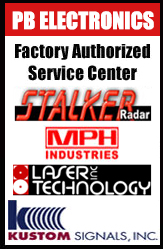| I sold a K-55 Radar to a man, Steve
Patterson, whose dad designed the original K-55. I asked
him to tell "The Rest of the Story!"
Hi Paul,
My son, Steve,
gave me a copy of his correspondence with you concerning the
K55 radar. I'd be happy to give you what history I know on
police radar. I first became familiar with police radar in
the mid 60's when I was working with a local consultant
named Fred Berry. Fred had designed the Dominator radar for
Jack Fritzland, which was later sold to some company in New
Jersey, as I recall. Fred Berry was also designing Guitar
amplifiers for Buddy Ross at Kustom Electronics in Chanute
Kansas. After Jack's no compete expired, it was decided that
Kustom would enter the police field, since Jack knew the
ropes of that field. Kustom Signal was then formed and
headed by Jack Fritzland, Later Ed Sergent and Ken McCoy
would be hired for the sales dept. Kustom was having
enormous success with their guitar amp and music products.
Fred Berry suggested to Buddy Ross that he hire me to head a
newly formed R&D dept., here in the Kansas City area. So in
January of 1969, I became full time at Kustom R&D. Buddy
Ross wanted Fred to work full time, too, but Fred had more
fun in his consulting practice.
Soon work on the TR6 radar had begun, Consultants from in
Wichita were hired to do the microwave and antenna design,
In the original design Boeing, had a klystron for the
source, but to our glee, Monsanto Company had just announced
their Gunn oscillator to the market and so the TR6 became
the first all solid state police radar! I really had little
to do with this radar, as I was busy designing guitar amps.
I did design some regulators and something in the audio. The
TR6 was a whopping success since the only competition was
Decatur and very few others
By the end of 69, partially due to personal changes and
other things, I left Kustom to design medical products for a
small local company. By the early 70's though, Jack
Fritzland had left Kustom and decided to start another
company! The new company was CMI and Jack had the vision of
a hand held unit. Jack contracted me to do the analog and
power supply work and Gene Lundy to design the package.
Soon, McCoy and Sergent were on board to run the sale of the
"SpeedGun" Gene Lundy gave it the name and obviously it has
become generic. The first SpeedGun was a poor performer,
though, as the antenna was totally contained in the unit. At
Ed Sergents insistence, the antenna was extended beyond the
end and it worked well enough to sell. Jack Fritzland was an
enthusiastic skier and soon moved the company to Minturn
Colorado (near Vail) Ed and Ken had the sales operation in
Chanute, and I had new products and final assembly in Lee's
Summit. By the end of 74. Jack Fritzland decided to close
the Chanute operation and move everything to Minturn. With
that decision, having been made, Ed, Ken and myself decided
it was time for another radar company! I went back to
designing medical products by day and radar at night! At
last, I had a product to myself! Just me and non technical
salesmen! So I decided to do what's seldom done, that was to
design something that could be easily serviced and upgraded!
It took the entire year of 1974 working part time to do the
K55. as soon as it was finished, we had an order for 450
units! I had to scramble to assemble a manufacturing
operation! so in 1500 square feet, shared with my metal
supplier, we produced the first 5000 K55's! as luck would
have it, they worked well and we had few problems...Soon
every tech was telling us how great the K55 was to service
and maintain! Everything was really great till Kustom
decided to sue us for patent infringement! as you probably
well know, there is little in common with the Kustom radar
and the K55, even so having to fight this was a big blow to
us. Later the big trials by the detector people in Florida
and New jersey led to the Federal radar specs by NHTSA. The
announcement of this paralyzed radar sales and to make
matters worse, the Communications workers were trying to
organize MPH! My partners decided to close the Lee's Summit
operation and move everything to Chanute (does this sound
familiar?) with that, I sold my 1/3'd to Ed and Ken and
started Progress Instruments at the end of 82. In 83 I
incorporated and begin producing DC motor speed controls
agricultural salt spreaders, tennis ball machines and golf
caddies, A couple of years ago, I retired and turned the
business over to my son, who has now multiplied it by over
ten times! It was good to see another K55 and the last time
I knew, MPD was still making it after 27.. years!
Serviceability did make a difference in product life!
I have to go now, don't hesitate to ask me anything, I'm
retired and just mostly free.
..........Bob Patterson
And in another email
he said:
Paul,
Please feel free to use this story any way you like. There
is really a lot more detail but it's probably not pertinent
to the big picture.
When we formed MPH I wanted to call it Xecar (Seek car),
but McCoy and Sergent quickly squelched that (bad) idea and
suggested MPH ! I agreed quickly and had my old friend,
Jose Conde, from my Vendo days, design the MPH logo, which,
as far as I know, is still in use.
Some of the ideas for the K55 came from my experience in
designing telephone EKG equipment for transmitting heart
EKG's to specialists This was done with a 1300 Hz signal
FM'd +/- 250 Hz....It worked well, till the phone line
became noisy so I added a phase locked loop filter that
worked so well that it would record when the signals were
barely audible at all ! Naturally, when the K55 was rolling
over in my mind, it became apparent that phase locked loops
would play a major part. As it turned out, phase locked
loops provided both the verification (validly) and was the
basis for the tracking filter! The tracking filter alone was
responsible for a 13 db signal to noise improvement. The
original choice of op amps turned out to be a problem, so
comparators and better op amps with smaller offsets resolved
that issue. Another goal of the K55 was to have real time
subtraction. As it turned out this solved any perceived
problem of closing speed and own speed not occurring ,
(ugh). Again, the double edge subtractor turned out to be
the simplest solution, as well. The subtractor and the
tracking filter was an original design. The verification
phase locked loop is straight out of the RCA handbook. The
fixed active filters underwent improvement as op amps and
techniques improved.
By the time MPH went into business, several manufactures
had Gunn oscillators. We used them all at one time or
another. It seemed that no one could produce a good
consistent unit, so we hopped from one to another. I decided
to see if we could build our own oscillator, so I contracted
John Brassfield to do this, The Brassfield oscillator worked
well, was small and low noise and had $8.00 in parts as
opposed to a $34-$40 GE or Microwave Associates package.
Getting consistent mixer diodes was always a problem, too.
We'd go for months with no problems, then they would all go
sour and the manufactures would just shrug!
An interesting sideline, early on, was GE's insistence on
testing my voltage regulator before guaranteeing their
oscillators. The PNP low drop out regulator was original,
too. That same circuit is used in my buddy's cap tester and
monitor test pattern generator, today. A slight mod on the
circuit made it an electronic circuit breaker, protecting it
from shorts and overloads. I sure could have used a cap
tester when I was doing medical equipment. Early small
electrolytics were not what they are today...One piece of
medical equipment that we sold would be inspected for the
presence of Cornell Dublier electrolytics, if any were
present, they were replaced! the failure was almost always
in ESR, not capacitance...I did have a problem with some
IT&T tantalum caps that would explode! There were all red,
and we advised that any red "bomb" be replaced.
All this brings back a lot of forgotten incidences...no
wonder I ramble so badly...I'll later tell you some of the
K15 and S80 stories..............................Bob
Patterson |



